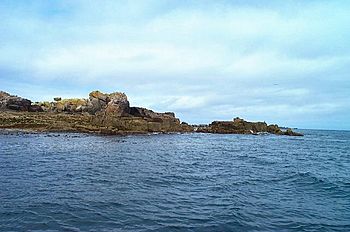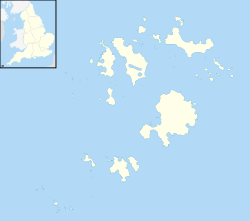Rosevear, Isles of Scilly facts for kids
|
Ros Veur
|
|
|---|---|

Northern tip of Rosevear
|
|
| Geography | |
| Coordinates | 49°52′N 6°24′W / 49.87°N 6.40°W |
| OS grid reference | SV839059 |
| Archipelago | Isles of Scilly |
| Administration | |
|
United Kingdom
|
|
| Civil parish | St Agnes |
| Demographics | |
| Population | 0 |
Rosevear (which means "great promontory" in Cornish, Cornish: Ros Veur) is the biggest rock in a group called the Western Rocks. These rocks are part of the Isles of Scilly, located in the Atlantic Ocean. They are found near the southwest coast of Great Britain.
The area around Rosevear is famous for many shipwrecks. The Bishop Rock lighthouse is also nearby. Rosevear and other uninhabited islands in the area belong to the Duchy of Cornwall. This is a special estate that provides income for the heir to the British throne. The islands are looked after by the Isles of Scilly Wildlife Trust. This group protects the old buildings, history, plants, and animals on the islands. Visitors are not allowed to land on Rosevear.
Contents
About Rosevear Island
Rosevear is the largest of the Western Rocks. It has a fairly flat top that rises about 5 meters (16 feet) high. The island is part of a group of rocks that stretches for about 3 kilometers (1.9 miles). This group goes from Round Rock of Crebawethan in the north to Pednathise Head in the south.
A Look at Rosevear's Past
Rosevear has an interesting history, especially with shipwrecks and lighthouse building.
Early Expeditions and Shipwrecks
In 1709 and 1710, Rosevear was used as a base camp. This was for the Herbert salvage expedition. They were trying to recover items from the sunken ships of the 1707 naval disaster. One of these ships was the HMS Association.
The Ghost of Ann Cargill
People say that the ghost of opera singer Ann Cargill haunts Rosevear. She died when her ship, the Nancy, sank near the island on February 24, 1784. Ann's body was found holding her 18-month-old son. They were first buried on Rosevear. Later, they were moved to Old Town Church on St Mary's.
Building the Bishop Rock Lighthouse
In the 1840s and 1850s, workers lived on Rosevear again. They were building the Bishop Rock lighthouse. This lighthouse is about 3.2 kilometers (2 miles) away. Rosevear was chosen as the base because it was the closest flat island.
The island was used from 1847 to 1850 for the first attempt to build the lighthouse. This attempt was not successful. Then, from 1851 to 1858, it was used for the successful construction. You can still see parts of their base today. There are remains of two buildings: a lodge for workers and a workshop. There is also a platform by the east coast and a smiths hearth (a place for metalworking). Another building can be seen further south.
The Cité de Verdun Wreck
Among the rocks of Rosevear, you can find a ship's funnel. This comes from the ship Cité de Verdun. It was wrecked on Rosevear in 1925.
Wildlife and Nature
It is difficult to land on Rosevear, and visitors are not encouraged. Because of this, there are not many detailed records from naturalists.
Protected Area for Wildlife
In 1971, Rosevear and the nearby rocks were named a Site of Special Scientific Interest. This means they are important for their breeding seabirds.
Bird Life on Rosevear
Around 1947, a visit by Geoffrey Grigson found Atlantic puffins, many razorbills, European shags, and great black-backed gulls. In October 1990, Rosemary Parslow saw many migrating birds. There were dozens of European robins and goldcrests. Several yellow-browed warblers were also seen, all feeding among the plants.
Rosevear has become a very important place for European storm petrels. It is now the third largest colony for these birds in England. In 2000, 57 nesting sites were found. By 2006, this number had grown to 129. The colony of European shags on Rosevear and the other Western Rocks is also very important for the country.
Plants of the Island
During storms, the sea can wash over Rosevear. Because of this, the island has special plants that can grow in shingle (small stones). These include tree mallow, sea curled dock, and Atriplex species. Other plants found here are sea beet, common scurvygrass, and rock sea-spurry.


